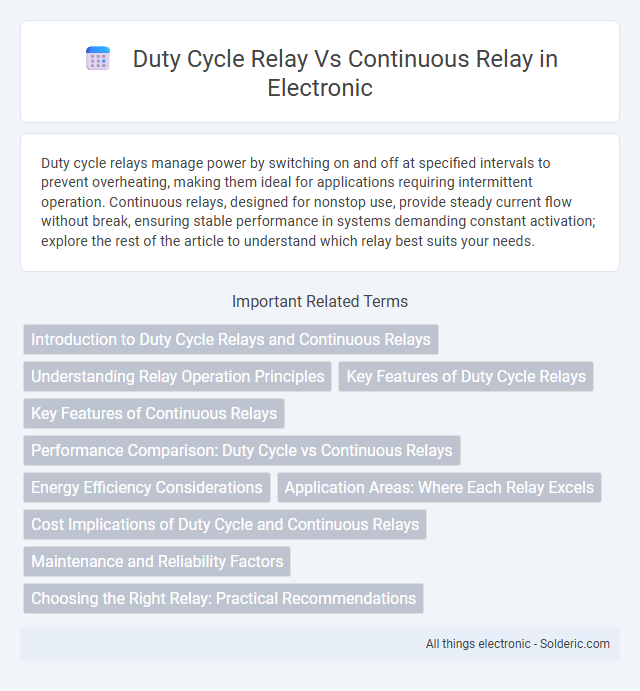Duty cycle relays manage power by switching on and off at specified intervals to prevent overheating, making them ideal for applications requiring intermittent operation. Continuous relays, designed for nonstop use, provide steady current flow without break, ensuring stable performance in systems demanding constant activation; explore the rest of the article to understand which relay best suits your needs.
Comparison Table
| Feature | Duty Cycle Relay | Continuous Relay |
|---|---|---|
| Operation Mode | Operates intermittently based on duty cycle (on/off periods) | Operates continuously without interruption |
| Heat Management | Designed to prevent overheating by limiting active time | Built to withstand continuous current with robust cooling |
| Typical Applications | Pumps, compressors, and devices needing periodic operation | Lighting, motors, and appliances requiring constant operation |
| Power Handling | Handles power in cycles, allowing rest periods to cool | Handles sustained power without cycle interruptions |
| Durability | Optimized for repetitive on/off cycles with thermal protection | Designed for long-term continuous use |
| Cost | Generally lower cost due to less robust cooling requirements | Higher cost because of enhanced durability and cooling design |
Introduction to Duty Cycle Relays and Continuous Relays
Duty cycle relays operate in intermittent intervals, designed to handle cyclical loads without overheating by regulating the ratio of ON time to OFF time, making them ideal for applications requiring controlled power bursts. Continuous relays are built for non-stop operation, delivering steady current flow without interruption, suitable for devices needing sustained power without the risk of relay coil damage. Your choice between duty cycle and continuous relays depends on the load pattern and thermal management requirements of your electrical system.
Understanding Relay Operation Principles
Duty cycle relays operate by switching on and off in predetermined intervals to manage power loads and prevent overheating, making them ideal for intermittent duty applications. Continuous relays maintain a steady, uninterrupted current flow to support constant load requirements without power cycling. Understanding the relay operation principles involves recognizing that duty cycle relays use timed cycles to control energy delivery, while continuous relays provide stable, ongoing power for devices demanding consistent operation.
Key Features of Duty Cycle Relays
Duty cycle relays are designed to operate within specific time intervals, allowing controlled on/off switching to prevent overheating and extend component lifespan. These relays provide precise control over the duration and frequency of electrical load cycles, making them ideal for applications requiring intermittent operation. They typically feature adjustable timing settings, high thermal stability, and enhanced durability under repeated cycling conditions.
Key Features of Continuous Relays
Continuous relays operate without interruption, providing a steady and stable current flow essential for applications requiring consistent power delivery. Key features include high durability under constant load conditions, enhanced thermal management to prevent overheating, and seamless operation that minimizes electrical noise and signal distortion. These relays excel in industrial automation and motor control systems where precise and reliable continuous switching is critical.
Performance Comparison: Duty Cycle vs Continuous Relays
Duty cycle relays operate by switching on and off in cycles, reducing heat buildup and improving energy efficiency, which makes them ideal for applications requiring intermittent operation. Continuous relays provide a steady, uninterrupted current flow, offering consistent performance suitable for high-load or constant-duty applications but may experience higher thermal stress. The choice between duty cycle and continuous relays depends on load characteristics, thermal management, and operational cycles, where duty cycle relays excel in energy optimization while continuous relays deliver stable, long-duration performance.
Energy Efficiency Considerations
Duty cycle relays improve energy efficiency by operating intermittently, reducing power consumption during idle periods and minimizing heat generation. Continuous relays consume constant power, which can lead to higher energy costs and increased thermal stress on components. Selecting a duty cycle relay in applications with periodic operation enhances overall system efficiency and extends relay lifespan.
Application Areas: Where Each Relay Excels
Duty cycle relays excel in applications requiring precise timing control and energy efficiency, such as HVAC systems, industrial automation, and motor control, where intermittent operation prevents overheating and extends component life. Continuous relays are ideal for applications demanding uninterrupted power flow, including lighting circuits, power distribution, and continuous process control, ensuring steady performance without disruption. Selecting the appropriate relay depends on the operational demands of the system, with duty cycle relays favoring cyclic tasks and continuous relays suited for constant load management.
Cost Implications of Duty Cycle and Continuous Relays
Duty cycle relays often incur higher initial costs due to their complex design optimized for handling intermittent loads and prolonged switching intervals. Continuous relays typically offer lower upfront prices but may result in increased maintenance expenses and shorter lifespan when used in applications with frequent switching demands. Evaluating total cost of ownership requires considering both the purchase price and operational longevity relative to the application's switching frequency.
Maintenance and Reliability Factors
Duty cycle relays require periodic downtime to prevent overheating, which can increase maintenance frequency and reduce operational reliability in continuous-use applications. Continuous relays are designed for nonstop operation with enhanced thermal management, minimizing maintenance needs and improving system uptime. Choosing the right relay impacts your maintenance schedule and long-term reliability, especially in high-demand environments.
Choosing the Right Relay: Practical Recommendations
Duty cycle relays are ideal for applications requiring intermittent operation and heat dissipation management, preventing overheating during repeated cycles, whereas continuous relays are designed for sustained operation without interruption. Selecting the right relay depends on load type, operating duration, and thermal constraints, with duty cycle relays suited for motors and compressors experiencing frequent start-stop cycles. For continuous loads such as lighting or solenoids, continuous relays provide reliability and longevity by supporting constant current flow without thermal stress.
Duty cycle relay vs continuous relay Infographic

 solderic.com
solderic.com